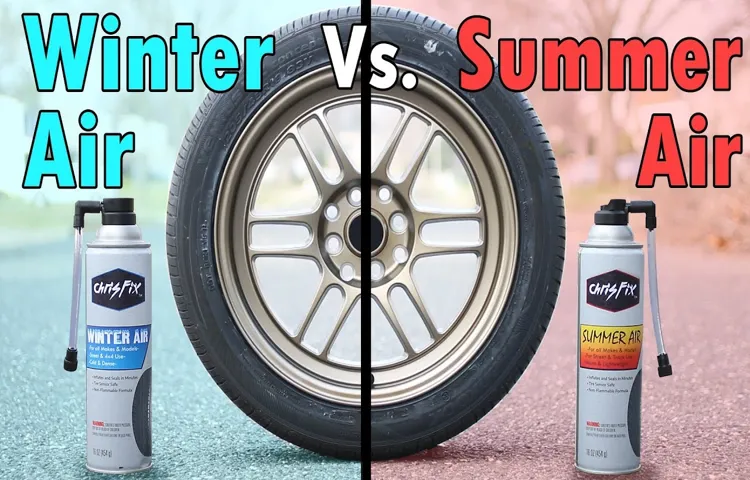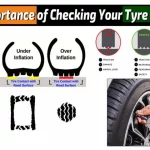If you’ve ever tried to inflate your tire but couldn’t seem to get it filled up with air, you might be wondering: why isn’t my tire filling up? It’s a frustrating experience that can leave you feeling helpless and unsure about what to do next. Fortunately, there are a few common reasons why this might be happening, and some simple solutions you can try to get your tire back to its proper pressure level. So, put down that tire gauge and keep reading to find out what might be causing the issue and how you can fix it.
One of the most likely culprits is a leak in your tire. Even if it’s a tiny hole, air can escape quickly and make it difficult to inflate your tire fully. Another possibility is a damaged valve stem that’s preventing the air from flowing in properly.
Sometimes, it can even be caused by a faulty tire gauge that’s not giving you an accurate reading. Whatever the issue might be, the key is to diagnose the problem as quickly as possible so you can take action and get your tire inflated properly. So, don’t give up just yet! With a little bit of investigation, you should be able to figure out what’s causing your tire to resist inflation, and find a solution that works for you.
Whether it’s a matter of patching up a leak, replacing a valve stem, or simply investing in a new tire gauge, there’s always a way to get your tire back to its optimal pressure level. So, grab your tools, give your tire a once-over, and get ready to tackle this frustrating problem head-on!
Table of Contents
Check for punctures or leaks
If you find that your tire is not filling up with air, one of the first things you should check for is punctures or leaks. Even a small puncture or leak can cause your tire to lose air over time, and eventually, it may become flat. You can easily check for punctures or leaks by inspecting your tire carefully for any visible signs of damage.
This includes checking the sidewalls, tread, and valve stem for any tears, cuts, or cracks. Additionally, you can spray your tire with soapy water and watch for bubbles to appear, which indicates the location of a leak. If you do identify a puncture or leak, it’s important to repair it as soon as possible to avoid further damage to your tire.
In some cases, a simple patch or plug can fix the issue, but if the damage is extensive, you may need to replace the tire altogether. Overall, staying vigilant and regularly inspecting your tires can help you avoid unexpected flat tires and keep your vehicle running smoothly.
Look for visible damage on the tire
When it comes to inspecting your tires for damage, a puncture or leak can be one of the most noticeable issues to look for. These types of damages can occur from a variety of sources such as nails or other sharp objects on the road. To check for punctures or leaks, start by giving your tires a thorough visual inspection.
Look for any signs of a puncture like a nail or screw embedded in the tire. You can also check for leaks by feeling around the tire for any soft spots or bulges. If you suspect a puncture or leak, it’s important to have it repaired as soon as possible.
Continuing to drive on a damaged tire can lead to further problems like a blowout or loss of air pressure. In short, always keep an eye out for any visible damage on your tires, including punctures or leaks, to ensure your safety on the road.

Test for leaks using soapy water
If you suspect that your plumbing system is leaking, it’s important to identify and repair the issue as quickly as possible. One effective method for checking for leaks is by using soapy water. This process involves applying soapy water to areas where a leak is suspected, such as around pipe joints or fittings.
If bubbles start to form, it’s a sign that air is escaping through a puncture or small hole. Once you’ve located the leak, you can take necessary steps to repair it and prevent further damage. Soapy water testing is a simple and cost-effective way to check for leaks in your plumbing system, and it can save you money in the long run by preventing more serious issues from developing.
So, if you suspect a leak, grab some soapy water and start checking!
Check the valve stem
Have you ever tried to fill up your tire with air, but it just won’t seem to inflate? While there could be a number of reasons why this is happening, one of the most common culprits is a problem with the valve stem. The valve stem is responsible for regulating air flow in and out of the tire, so if it’s not working properly, air won’t be able to enter the tire. Before you assume that your tire is flat for good, take a closer look at the valve stem.
Is it damaged or bent? Does it seem loose or worn out? If so, you may need to replace the valve stem to get your tire back in working order. By paying attention to the little details like the valve stem, you can ensure that your tires are always ready to go when you need them.
Make sure the cap is on tight
If you’ve ever had a flat tire, you know how frustrating and time-consuming it can be to change it. That’s why it’s important to take the proper precautions to ensure your tires stay in good condition. One of the most important things you can do is make sure the cap is on tight and check the valve stem regularly.
Over time, the valve stem can become cracked or corroded, leading to air leaks. This can cause your tire to lose pressure more quickly, which can lead to a flat tire. By checking the valve stem regularly, you can catch any issues early and prevent a flat tire from happening.
Additionally, making sure the cap is on tight helps to prevent dirt and debris from getting into the valve stem, which can also cause air leaks. So next time you fill up your tires, take a few extra seconds to check the valve stem and make sure the cap is on tight. It could save you a lot of time and hassle down the road.
Check for damage to the valve stem
When inspecting your tires, it’s important to check for damage to the valve stem. The valve stem is essentially the gateway for air to enter and exit your tire, so it’s crucial that it remains in good condition. Start by examining the valve stem for any cracks or tears.
These small imperfections may not seem like a big deal, but they can allow air to leak out of your tire over time. Additionally, make sure the valve cap is securely in place. The cap helps to prevent dust and debris from clogging the valve stem, which can also lead to air leaks.
Checking the valve stem is a simple task that can save you from potential tire problems down the road. So, next time you’re giving your tires a once-over, don’t forget to inspect the valve stem!
Check the air pump
So, you got a flat tire and you’re wondering why isn’t my tire filling up with air? Don’t panic just yet. One of the most common reasons for a tire not filling up with air is a faulty or malfunctioning air pump. Check the air pump and the hose to make sure there are no cracks or leaks.
If the air pump seems to be working fine, try another one, or take your car to a nearby gas station or mechanic to use their air pump. It’s also important to check the tire’s valve stem, as it may be damaged or obstructed. Remember, safety first, so don’t drive on a flat tire for too long as it can cause damage to both the tire and your vehicle.
Stay safe on the road, folks!
Make sure it is plugged in and turned on
Have you ever found yourself in the middle of an aquarium crisis, only to realize that the problem is as simple as forgetting to turn on your air pump? It’s happened to the best of us. The first thing you should always check when troubleshooting aquarium equipment is if it is plugged in and turned on. It may seem obvious, but it’s easy to overlook in a moment of panic.
Once you’ve verified that your pump is receiving power, it’s time to take a closer look. Is the air pump making noise? If so, it’s likely that something is clogging the air intake, such as debris or algae. Try cleaning the air filter or check valves.
If the pump isn’t making any noise, it may be time to replace it. Remember that checking the air pump is the first step to ensure your aquarium stays healthy and your aquatic creatures stay happy!
Check for blockages or damage to the hose
When it comes to troubleshooting your vacuum cleaner, a common issue can be a blockage or damage in the hose. However, it’s also important to check the air pump. The air pump is responsible for creating the suction necessary for your vacuum to effectively pick up dirt and debris.
If there is a blockage or damage to the air pump, this can greatly reduce the suction power of your vacuum. To check the air pump, turn off the vacuum and remove the filter or bag. Then, locate the air pump and inspect it for any visible damage or blockages.
If you notice any issues, it may be necessary to clean or replace the air pump. By taking the time to thoroughly check both the hose and the air pump, you can ensure that your vacuum cleaner is in top form and ready to tackle even the toughest messes.
Consider other factors
Why isn’t my tire filling up with air? There could be several reasons for this. It could be due to a punctured tire, a faulty valve stem, or a damaged rim. However, it’s important to consider other factors as well.
For instance, are you using the correct equipment to inflate your tire? If you’re using a pump that isn’t compatible with your valve stem, it could prevent the tire from filling up correctly. Additionally, if your tire is old or worn, it may not hold air as well as a newer tire would. It’s also possible that the temperature outside is affecting the air pressure in your tire.
Changes in temperature can cause fluctuations in tire pressure, so it’s essential to check your tires regularly and adjust the pressure as needed. By considering these other factors, you’ll be better equipped to determine why your tire isn’t filling up with air and take appropriate action to get it fixed.
Temperature can affect tire pressure
Temperature can have a noticeable impact on your tire pressure. As the temperature rises, so does the air pressure inside your tires. Conversely, as the temperature drops, the air pressure in your tires also decreases.
This can be a serious concern if you don’t pay attention to your tire pressure regularly. But it’s crucial to keep in mind that temperature isn’t the only factor that can affect your tire pressure. Other factors, such as the amount of weight your car is carrying and the condition of your tires, can also play a role.
It’s important to consider all of these factors when monitoring your tire pressure to ensure your safety on the road. So, if you notice your tire pressure fluctuating, it’s best to take your car to a professional mechanic to get it inspected and fixed in no time. Taking proper care of your tires will not only ensure your safety but also maximize their lifespan.
Age of the tire can impact its ability to hold air
While the age of the tire can certainly impact its ability to hold air, it’s important to consider other factors as well. For instance, if you have a small puncture or leak in your tire, it won’t matter how young or fresh the tire is – it simply won’t hold air. Additionally, extreme temperatures, improper installation or maintenance, and even driving habits can all contribute to a tire losing air pressure.
That’s why it’s important to routinely check your tire pressure and keep up with regular maintenance to maximize the lifespan and performance of your tires. And if you do notice a loss of pressure, be sure to address the issue promptly to avoid further damage or safety concerns on the road. Remember, while age is certainly a factor, it’s not always the only factor when it comes to tire pressure and performance.
Conclusion: Address the issue or seek professional help
Well my dear friend, it appears that the air in your tire has gone on a vacation! Whether it’s hiding in a tiny hole or simply escaped through a sneaky leak, we may never know. But fear not, for with a little bit of investigation and some handy dandy tools, we can bring that air back to where it belongs- in your tire, ready for a smooth ride ahead. So let’s get to work and give that tire the breath of life it deserves!”
FAQs
What are some common reasons why tires don’t fill up with air properly?
There are several possible reasons for this issue, including a damaged valve stem, a punctured tire, or a malfunctioning air compressor.
What should I do if my tire doesn’t seem to be holding air?
First, you should check for any visible damage or punctures in the tire. If you don’t see anything obvious, try inflating the tire again and see if it holds air. If not, you may need to take the tire to a professional for repair or replacement.
Can cold weather affect tire pressure?
Yes, cold weather can cause your tire pressure to drop, as the air inside the tire contracts in colder temperatures. This is why it’s important to check your tire pressure regularly, especially during winter months.
How often should I check my tire pressure?
It’s a good idea to check your tire pressure at least once a month, as well as before long road trips or in extreme weather conditions.
What are some tips for properly inflating my tires?
Make sure to use the correct tire pressure for your specific vehicle, and always inflate your tires when they are cold (rather than hot from driving). Additionally, be sure to check your tire pressure with a quality gauge and never over-inflate your tires.
Can over-inflating my tires be dangerous?
Yes, over-inflating your tires can actually be just as dangerous as under-inflating them. Over-inflated tires can result in decreased traction, increased risk of a blowout, and uneven wear on your tires.
When should I replace my tires altogether?
It’s typically recommended to replace your tires every 6 years, regardless of how much tread is left. Additionally, if you notice any significant damage or punctures in your tire, it’s best to replace it as soon as possible.



